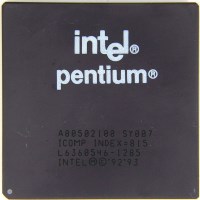 On this day in 1993, Intel released the first Pentium CPU. It ran at 60 MHz — 60 million cycles per second. Think about that: the little clock inside that chip was going from 0 to 5 volts and back to 0 volts: 60 million times every second! That still boggles my mind. Meanwhile, the computer I’m writing this on has a clock speed of 3.1 GHz — 3,100 million cycles per second — fifty times faster. I think the more you know about computers, the more amazing they are. To most people they are just a given. It shocks me that this all works.
On this day in 1993, Intel released the first Pentium CPU. It ran at 60 MHz — 60 million cycles per second. Think about that: the little clock inside that chip was going from 0 to 5 volts and back to 0 volts: 60 million times every second! That still boggles my mind. Meanwhile, the computer I’m writing this on has a clock speed of 3.1 GHz — 3,100 million cycles per second — fifty times faster. I think the more you know about computers, the more amazing they are. To most people they are just a given. It shocks me that this all works.
Anyway, I remember at the time that the Pentium was released, most people I knew scoffed at the name. There had been the 8086. And then there was the 80286 — confusingly called the “eighty-two eighty-six.” Soon everyone just called it the 286. The 386 was the first 32-bit version of the chip. And the 486 was just the 386 with a math co-processor, so no big deal. The 586 was a big deal. But it was the 586, not the Pentium. Did Intel really think their marketing campaign could get us all to use the silly new name?!
Well, I don’t know what Intel thought it could or could not do. But I do know that very soon everyone called it the Pentium. And after a few years, most people just gave you blank stares if you mentioned the 586 (much less the 80586). It’s like when I used to confuse people by calling Windows 2000 what it actually was: Windows 5.0. XP was Windows 5.1. I don’t mean to be difficult, but it’s actually a lot easier than things like “Windows Vista” (Windows 6.0).
The Pentium Name Means Nothing
It’s the power of marketing. And the amazing thing is that the name — Pentium — didn’t mean anything. The original Pentium had P5 microarchitecture. Within three years, Intel was selling the Pentium II, which had a P6 microarchitecture — more or less the 80686, although they didn’t call it that. The Pentium IV which had NetBurst microarchitecture, which would have been called the 80786 in a sane world.
We have the same thing today. Do you have an i3 in your computer? Or maybe an i5 or an i7? These names are meaningless because the chips keep changing. It’s all about branding. And I hate it! It isn’t because I’m a snob. I just want things to be clear. When you bought an 80286, you knew what you were getting. Now, you need to know a whole lot more than what chip you are talking about and what its clock speed is. In fact, my i5 might be more powerful than your i7 — or less powerful than your i3. I don’t know. I don’t care. I let Will make my computer decisions for me. And thank God for that! Otherwise, I’d be nuttier than I already am.






Intel used ‘Pentium’ because they could trademark a name like that, but not the 80×86 series of numbers. Though there was a lot of hope that the word had a positive image.
http://www.newyorker.com/magazine/2011/10/03/famous-names
In the news today: Andy Grove has died: http://www.bbc.com/news/technology-35221693
Interesting. But the issue isn’t really that they would want to do that but that we would all go along with it.
Sad about Grove.
To amplify what Barney said:
When IBM was designing (what would become) the PC, they wanted to make sure that mass production wouldn’t be held hostage by any of their major suppliers. So when they chose the 8086/8088 chip as the CPU, they forced Intel to license it to other chip foundries to meet the projected demand.
Flash forward a few years to the burgeoning PC-compatible market; every time Intel came out with a new chip in the x86 family, AMD came out with a clone shortly afterward, with an eerily-similar name. In fact, AMD’s 386 and 486 clones were generally better than Intel’s originals – plus, you could buy an AMD 386DX-40 for less money than an Intel 80386SX-33 (the DX included a dedicated coprocessor for floating-point math; the SX didn’t.)
Intel tried to fight AMD (and Cyrix, and a few others whose names I’ve forgotten) on the cloning front, but the IBM contract held; they tried to trademark the numeric sequences “286”, 386″, and “486” but were shot down. So in the next generation they did two things: they changed the processor architecture fundamentally enough that future clones would have to be reverse-engineered, and they came up with a trademarkable name that still evoked the “5-ness” of the new chip.
Incidentally, when Intel and AMD turned their minds toward the 64-bit future, Intel put forward a design that broke backward compatibility – if you had an Itanium machine, you couldn’t run x86 software. AMD, true to their scrappy-underdog tradition, came up with a 64-bit “bolt-on” to the x86 design – it sacrificed 64-bit purity, and a bit of efficiency, in exchange for backward compatibility. (Also it was much, much cheaper.) After a few years, Intel gave in and licensed AMD’s technology, and the circle was complete – AMD licenses x86 from Intel, and Intel licenses x64 from AMD.
And nobody calls the new generation of chips “686” or “786”.
Aw, poop. I misremembered – in the 386 generation, the math co-pro was the 387; it was the 486DX that combined the two and the 486SX was essentially just a 386.
The 386SX had a 16-bit bus rather than the DX’s 32-bit bus and was slower; that was the market-segmentation gimmick.
“SX” was always Intel marketing-speak for “let’s break the legs of our flagship product and sell it to the low end of the market”; exactly what kind of leg-breaking took place varied by generation. No wonder they hated AMD so badly…
http://redhill.net.au/c/c-4.html
I never understood the SX. Why have a 32 bit processor and a 16 bit bus? Of course the x86 family has always been weird.
Two reasons, I believe:
– Market segmentation, AKA “Never leave money on the table.”
– Ability to salvage sub-par parts. As I understood it, chips that didn’t quite pass QA were re-tested to a lower specification; if they passed, they were sold as SX parts. At least, that’s how things (are supposed to have) started…
That sounds about right. Given the amazing technology it isn’t surprising that a lot of chips failed and that they would want to cut their losses.
I didn’t know that early AMD history; I thought they always reverse engineered the chips. I don’t know the status at this point but for some time the AMD 64 bit chips were considerably faster running 32 bit code. But in my experience, AMD processors run a lot hotter.
In my experience as well, at least for most of the desktop CPUs in the stretch between the 486DX2/66 and the AthlonX2 (oh yes, I built many many machines with that series of chips!)
More recently, however, I’ve found that AMD’s notebook APUs (that’s what they call their integrated CPU/GPU combos) are safer than Intel’s – at least for Intel machines with Intel graphics; I haven’t had much experience with Intel/nVidia laptops. In the Intel/Intel machines, though, the CPU and GPU are separate chips, a few centimeters apart – but covered by a single flat metal heatsink! If the motherboard flexes – if, for instance, the user carries the notebook around in a bag rather than treating it as a sacred relic – the heatsink will slightly separate from the top of the GPU, disrupting the thermal compound. And then, very shortly, the GPU will overheat and the laptop will die.
By contrast, AMD’s APUs are a single chip; they may run hotter (I can’t really tell) but I have yet to see one fry itself. Also they’re cheaper; Intel’s top-of-the-line i7 outperforms AMD’s top-of-the-line A10, but not by enough to justify the price differential as far as I can tell.
You should talk to Will. He’s very big on CPUs and heart sinks and thermal paste and all that jazz. I still find it amazing that laptops manage to not overheat. That’s actually why I think AMD chips run hotter: I’ve had more problems with AMD laptops — but nothing a laptop cooler won’t address.
Also: RIP Andy Grove. One of the greats.
Don’t know whether you’re into television, but you might recall a one-season-wonder called “The Lone Gunmen,” which was a spinoff of the original “The X Files,” revolving around the character Langley from that series. The pilot episode, aired in spring of 2001, featured a thwarted false-flag op that involved crashing a civilian airliner into the World Trade Center. The MO in this case wasn’t hijacking the plane, but hacking the autopilot system. One of the main characters in the show was a pre-release CPU (embedded in the autopilot) called the “Octium.”
Yeah — that idea’s shown up in pop fiction before. A Tom Clancy novel had a Japanese pilot attacking a joint session of Congress with a jet. And it would have cost a few dollars per plane to add lockable cabin doors, but too late now.
I’ve never seen The X-Files, but a friend of mine made me watch that pilot episode. I was not kind when I wrote about it. But I did note that the plot was clever. And actually, the series might have been good. I only saw that episode, and pilots are often weak.